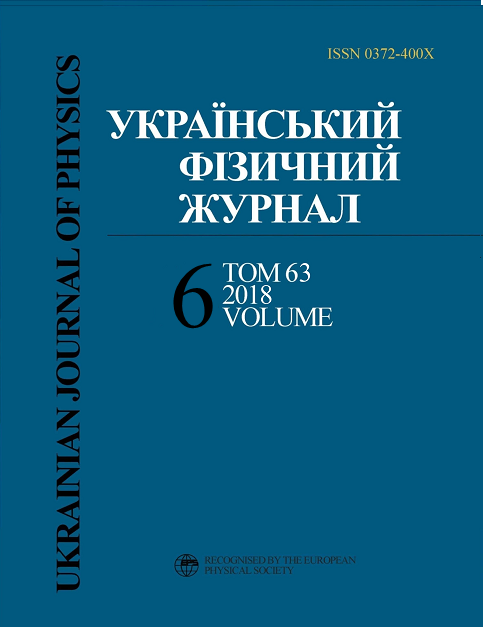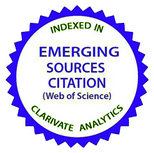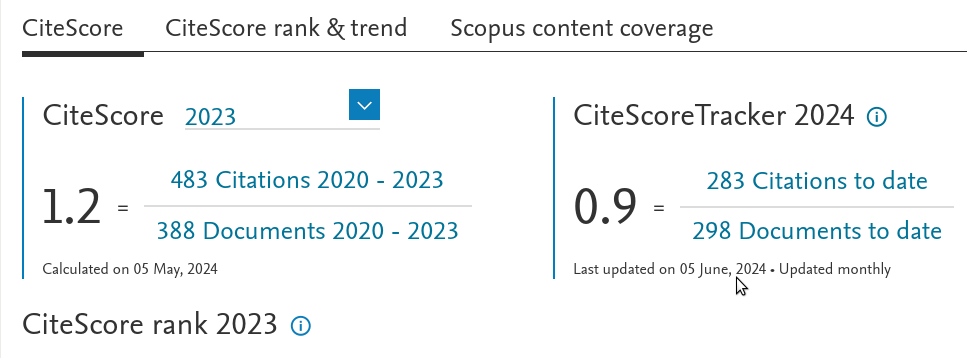Коливальна спектроскопія комплексоутворення у водних розчинах ізопропанолу
DOI:
https://doi.org/10.15407/ujpe63.6.506Ключові слова:
complex formation, ATR FTIR spectroscopy, 2D correlation spectroscopy, multivariate curve resolutionАнотація
Було дослiджено комплексоутворення у розчинах iзопропанолу з водою методами коливальної спектроскопiї. ППВВ спектри IЧ поглинання в режимi було вимiряно при рiзних концентрацiях розчину. Багатовимiрне роздiлення кривих експериментальних даних показало, що дослiджуваний розчин можна розглядати як чотирикомпонентну сумiш, що мiстить двi незв’язанi компоненти (“чисту” воду та “чистий” iзопропанол) та два молекулярнi комплекси.
Посилання
<li>M.K. Alam, J.B. Callis. Elucidation of species in alcohol-water mixtures using near-IR spectroscopy and multivariate statistics, Anal. Chem. 66, 2293 (1994).
<a href="https://doi.org/10.1021/ac00086a015">https://doi.org/10.1021/ac00086a015</a>
</li>
<li>K. Yoshida, T. Yamaguchi. Low-frequency Raman spectroscopy of aqueous solutions of aliphatic alcohols. Z. Naturforsch. 56a, 529 (2001).
</li>
<li>J. McGregor, R. Li, J. Axel Zeitler, C. D'Agostino, J.H.P. Collins, M.D. Mantle, H. Mayar, J.D. Holbrey, M. Falkowska, T.G.A. Youngs, C. Hardacre, E. Hugh Stitt, L.F. Gladden. Structure and dynamics of aqueous 2-propanol: a THz-TDS, NMR and neutron diffraction study. Phys. Chem. Chem. Phys. 17, 30481 (2015).
<a href="https://doi.org/10.1039/C5CP01132A">https://doi.org/10.1039/C5CP01132A</a>
</li>
<li>R. Li, C. D'Agostino, J. McGregor, M.D. Mantle, A. Zeitler, L.F. Gladden. Mesoscopic structuring and dynamics of alcohol/water solutions probed by terahertz time-domain spectroscopy and pulsed field gradient nuclear magnetic resonance. J. Phys. Chem. B 118, 10156 (2014).
<a href="https://doi.org/10.1021/jp502799x">https://doi.org/10.1021/jp502799x</a>
</li>
<li>H.-J. Tong, J.-Y. Yu, Y.-H. Zhang, J.P. Reid. Observation of conformation changes in 1-propanol-water complexes by FTIR spectroscopy. J. Phys. Chem. A 114, 6795 (2010).
<a href="https://doi.org/10.1021/jp912180d">https://doi.org/10.1021/jp912180d</a>
</li>
<li>J.W. Bye, C.L. Freeman, J.D. Howard, G. Herz, J. Mc-Gregor, R.J. Falconer. Analysis of mesoscopic structured 2-propanol/water mixtures using pressure perturbation calorimetry and molecular dynamic simulation. J. Solut. Chem. 46, 175 (2017).
<a href="https://doi.org/10.1007/s10953-016-0554-y">https://doi.org/10.1007/s10953-016-0554-y</a>
</li>
<li>L.A. Bulavin, A.V. Chalyi, O.I. Bilous. Anomalous propagation and scattering of sound in 2-propanol water solution near its singular point. J. Mol. Liq. 235, 24 (2017).
<a href="https://doi.org/10.1016/j.molliq.2017.01.040">https://doi.org/10.1016/j.molliq.2017.01.040</a>
</li>
<li>T. Sato, R. Buchner. Dielectric relaxation spectroscopy of 2-propanol-water mixtures. J. Chem. Phys. 118, 4606 (2003).
<a href="https://doi.org/10.1063/1.1543137">https://doi.org/10.1063/1.1543137</a>
</li>
<li>T. Sato, R. Buchner. The cooperative dynamics of the H-bond system in 2-propanol/water mixtures: Steric hindrance effects of nonpolar head group. J. Chem. Phys. 119, 10789 (2003).
<a href="https://doi.org/10.1063/1.1620996">https://doi.org/10.1063/1.1620996</a>
</li>
<li> D. Peeters, P. Huyskens. Endothermicity of water/alcohol mixtures. J. Mol. Struct. 300, 539 (1993).
<a href="https://doi.org/10.1016/0022-2860(93)87046-C">https://doi.org/10.1016/0022-2860(93)87046-C</a>
</li>
<li> L.A. Bulavin, V.Ya. Gotsulskii, N.P. Malomuzh, V.E. Chechko. Relaxation and equilibrium properties of dilute aqueous solutions of alcohols. Russ. Chem. Bull. 65, 851 (2016).
<a href="https://doi.org/10.1007/s11172-016-1391-2">https://doi.org/10.1007/s11172-016-1391-2</a>
</li>
<li> J.-H. Guo, Y. Luo, A. Augustsson, S. Kashtanov, J.-E. Rubensson, D.K. Shuh, H. ? Agren, J. Nordren. Molecular structure of alcohol-water mixtures. Phys. Rev. Lett. 91, 157401 (2003).
<a href="https://doi.org/10.1103/PhysRevLett.91.157401">https://doi.org/10.1103/PhysRevLett.91.157401</a>
</li>
<li> T.A. Dolenko, S.A. Burikov, S.A. Dolenko, A.O. Efitorov, I.V. Plastinin, V.I. Yuzhakov, S.V. Patsaeva. Raman Spectroscopy of Water-Ethanol Solutions: The Estimation of Hydrogen Bonding Energy and the Appearance of Clathrate-like Structures in Solutions. J. Phys. Chem. A, 119, 10806 (2015).
<a href="https://doi.org/10.1021/acs.jpca.5b06678">https://doi.org/10.1021/acs.jpca.5b06678</a>
</li>
<li> V.Ya. Gotsul'skii, N.P. Malomuzh, V.E. Chechko. Features of the temperature and concentration dependences of the contraction of aqueous solutions of ethanol. Russ. J. Phys. Chem. A 87, 1638 (2013).
<a href="https://doi.org/10.1134/S0036024413100087">https://doi.org/10.1134/S0036024413100087</a>
</li>
<li> H. Yilmaz. Excess properties of alcohol-water systems at 298.15 K. Turk. J. Phys. 26, 243 (2002).
</li>
<li> F.-M. Pang, C.-E. Seng, T.-T. Teng, M.H. Ibrahim. Densities and viscosities of aqueous solutions of 1-propanol and 2-propanol at temperatures from 293.15 K to 333.15 K. J. Mol. Liq. 136, 71 (2007).
<a href="https://doi.org/10.1016/j.molliq.2007.01.003">https://doi.org/10.1016/j.molliq.2007.01.003</a>
</li>
<li> A.Yu. Manakov, L.S. Aladko, A.G. Ogienko, A.I. Ancharov. Hydrate formation in the system of n-propanol-water. J. Therm. Anal. Calorim. 111, 885 (2013).
<a href="https://doi.org/10.1007/s10973-012-2246-1">https://doi.org/10.1007/s10973-012-2246-1</a>
</li>
<li> P. Tomza, M.A. Czarnecki. Microheterogeneity in binary mixtures of propyl alcohols with water: NIR spectroscopic, two-dimensional correlation and multivariate curve resolution study. J. Mol. Liq. 209, 115 (2015).
<a href="https://doi.org/10.1016/j.molliq.2015.05.033">https://doi.org/10.1016/j.molliq.2015.05.033</a>
</li>
<li> L.A. Bulavin, V.Ya. Gotsul'skii, N.P. Malomuzh, M.V. Stiranets. Refractometry of water-ethanol solutions near their contraction point. Ukr. J. Phys. 60, 1108 (2015).
<a href="https://doi.org/10.15407/ujpe60.11.1108">https://doi.org/10.15407/ujpe60.11.1108</a>
</li>
<li> K.C. Pratt, W.A. Wakeham. The mutual diffusion coefficient for binary mixtures of wster and the isomers of propanol. Proc. R. Soc. Lond. A. 342, 401 (1975).
<a href="https://doi.org/10.1098/rspa.1975.0031">https://doi.org/10.1098/rspa.1975.0031</a>
</li>
<li> K.R. Harris, T. Goscinska, H.N. Lam. Mutual diffusion coefficients for the systems water-ethanol and water-propan-1-ol at 25?C. J. Chem. Soc. Faraday Trans. 89, 1969 (1993).
<a href="https://doi.org/10.1039/FT9938901969">https://doi.org/10.1039/FT9938901969</a>
</li>
<li> A. Mialdun, V. Yasnou, V. Shevtsova, A. K?oniger, W. K?ohler, D. Alonso de Mezquia, M. M. Bou-Ali. A comprehensive study of diffusion, thermodiffusion, and Soret coefficients of waterisopropanol mixtures. J. Chem. Phys. 136, 244512 (2012).
<a href="https://doi.org/10.1063/1.4730306">https://doi.org/10.1063/1.4730306</a>
</li>
<li> L. Hao, D.G. Leaist. Binary mutual diffusion coefficients of aqueous alcohols. Methanol to 1-heptanol. J. Chem. Eng. Data 41, 210 (1996).
<a href="https://doi.org/10.1021/je950222q">https://doi.org/10.1021/je950222q</a>
</li>
<li> S. Dixit, J. Crain, W.C.K. Poon, J.L. Finney, A.K. Soper. Molecular segregation observed in a concentrated alcohol-water solution. Nature 416, 829 (2002).
<a href="https://doi.org/10.1038/416829a">https://doi.org/10.1038/416829a</a>
</li>
<li> J.G. Davis, K.P. Gierszal, P. Wang, D. Ben-Amotz. Water structural transformation at molecular hydrophobic interfaces. Nature 491, 582 (2012).
<a href="https://doi.org/10.1038/nature11570">https://doi.org/10.1038/nature11570</a>
</li>
<li> J.G. Davis, B.M. Rankin, K.P. Gierszal, D. Ben-Amotz. On the cooperativity of non-hydrogen-bonded water at molecular hydrophobic interfaces. Nature Chem. 5, 796 (2013).
<a href="https://doi.org/10.1038/nchem.1716">https://doi.org/10.1038/nchem.1716</a>
</li>
<li> V.V. Obukhovsky, V.V. Nikonova. Interdiffusion in water solutions of ethyl alcohol. Ukr. J. Phys. 55, 891 (2010).
</li>
<li> K.V. Cherevko, D.A. Gavryushenko, V.M. Sysoev. Stationary diffusion in the membrane systems with the ongoing reversible chemical reactions. J. Mol. Liq. 120, 71 (2005).
<a href="https://doi.org/10.1016/j.molliq.2004.07.038">https://doi.org/10.1016/j.molliq.2004.07.038</a>
</li>
<li> H.A. Zarei, S. Shahvarpour. Volumetric properties of binary and ternary liquid mixtures of 1-propanol (1) + 2-propanol (2) + water (3) at different temperatures and ambient pressure (81.5 kPa). J. Chem. Eng. Data 53, 1660 (2008).
<a href="https://doi.org/10.1021/je800158z">https://doi.org/10.1021/je800158z</a>
</li>
<li> J.-W. Shin, E.R. Bernstein. Experimental and theoretical studies of isolated neutral and ionic 2-propanol and their clusters. J. Chem. Phys. 130, 214306 (2009).
<a href="https://doi.org/10.1063/1.3148378">https://doi.org/10.1063/1.3148378</a>
</li>
<li> I.Yu. Doroshenko. Matrix isolation study of the formation of methanol cluster structures in the spectral region of C-O and O-H stretch vibrations. Low Temp. Phys. 37, 604 (2011).
<a href="https://doi.org/10.1063/1.3643482">https://doi.org/10.1063/1.3643482</a>
</li>
<li> G. Matisz, A.-M. Kelterer, W.M.F. Fabian, S. Kuns’agi-M’at’e. Application of the quantum cluster equilibrium (QCE) model for the liquid phase of primary alcohols using B3LYP and B3LYP-D DFT methods. J. Phys. Chem. B 115, 3936 (2011).
<a href="https://doi.org/10.1021/jp109950h">https://doi.org/10.1021/jp109950h</a>
</li>
<li> M. Starzak, M. Mathlouthi. Cluster composition of liquid water derived from laser-Raman spectra and molecular simulation data. Food Chem. 82, 3 (2003).
<a href="https://doi.org/10.1016/S0308-8146(02)00584-8">https://doi.org/10.1016/S0308-8146(02)00584-8</a>
</li>
<li> H. Cybulski, J. Sadlej. On the calculation of the vibrational Raman spectra of small water clusters. Chem. Phys. 342, 163 (2007).
<a href="https://doi.org/10.1016/j.chemphys.2007.09.058">https://doi.org/10.1016/j.chemphys.2007.09.058</a>
</li>
<li> S.R. Gadre, S.D. Yeole, N. Sahu. Quantum cluster investigations of molecular clusters. Chem. Rev. 114, 12132 (2014).
<a href="https://doi.org/10.1021/cr4006632">https://doi.org/10.1021/cr4006632</a>
</li>
<li> F. Weinhold. Quantum cluster equilibrium theory of liquids: Illustrative applications to water. J. Chem. Phys. 109, 373 (1998).
<a href="https://doi.org/10.1063/1.476574">https://doi.org/10.1063/1.476574</a>
</li>
<li> G. Matisz, A.-M. Kelterer, W.M.F. Fabian, S. Kuns’agi-M’at’e. Structural properties of methanol-water binary mixtures within the quantum cluster equilibrium model. Phys. Chem. Chem. Phys. 17, 8467 (2015).
<a href="https://doi.org/10.1039/C4CP05836D">https://doi.org/10.1039/C4CP05836D</a>
</li>
<li> H.F. Shurvel. Spectra-structure correlations in the mid- and far-infrared. In Handbook of Vibrational Spectroscopy. Edited by J.M. Chalmers, P.R. Griffiths (Wiley, 2002).
</li>
<li> L.G. Weyer, S.-C. Lo. Spectra-structure correlations in the near-infrared. In Handbook of Vibrational Spectroscopy. Edited by J.M. Chalmers, P.R. Griffiths (Wiley, 2002).
</li>
<li> H.G.M. Edwards. Spectra-structure correlations in Raman spectroscopy. In Handbook of Vibrational Spectroscopy. Edited by J.M. Chalmers, P.R. Griffiths (Wiley, 2002).
</li>
<li> A. de Juan, R. Tauler. Multivariate curve resolution-alternating least squares for spectroscopic data. In Resolving Spectral Mixtures with Applications from Ultrafast Time-Resolved Spectroscopy to Super-Resolution Imaging (Elsevier, 2016).
<a href="https://doi.org/10.1016/B978-0-444-63638-6.00002-4">https://doi.org/10.1016/B978-0-444-63638-6.00002-4</a>
</li>
<li> O. Ilchenko, V. Obukhovsky, V. Lemeshko, V. Nikonova, A. Kutsyk. Raman spectroscopy investigations of complexation processes in water-methanol solutions. Bulletin of T. Shevchenko Nat. Univ. of Kyiv. Radiophys. Electr. 17, 34 (2012).
</li>
<li> O.O. Ilchenko, Y.V. Pilgun, A.S. Reynt, A.M. Kutsyk. NNLS and MCR-ALS decomposition of Raman and FTIR spectra of multicomponent liquid solutions. Ukr. J. Phys. 61, 519 (2016).
<a href="https://doi.org/10.15407/ujpe61.06.0519">https://doi.org/10.15407/ujpe61.06.0519</a>
</li>
<li> Q. Li, N. Wang, Q. Zhou, S. Sun, Z. Yu. Excess infrared absorption spectroscopy and its applications in the studies of hydrogen bonds in alcohol-containing binary mixtures. Appl. Spec. 62, 166 (2008).
<a href="https://doi.org/10.1366/000370208783575663">https://doi.org/10.1366/000370208783575663</a>
</li>
<li> O. Ilchehko, V. Nikonova, A. Kutsyk, V. Obukhovsky. Quantitative analysis of complex formation in acetonechloroform and ethyl acetate-cyclohexane solutions. Ukr. J. Phys. 59, 268 (2014).
<a href="https://doi.org/10.15407/ujpe59.03.0268">https://doi.org/10.15407/ujpe59.03.0268</a>
</li>
<li> O.O. Ilchenko, A.M. Kutsyk, Y.V. Pilgun, V.V. Obukhovsky, V.V. Nikonova. Formation of molecular complexes in liquid benzene-chloroform mixtures examined by mid-IR 2D correlation spectroscopy and multivariate curve resolution. Ukr. J. Phys. 61, 508 (2016).
<a href="https://doi.org/10.15407/ujpe61.06.0508">https://doi.org/10.15407/ujpe61.06.0508</a>
</li>
<li> A. Kutsyk, O. Ilchenko, Y. Pilgun, V. Obukhovsky, V. Nikonova. Complex formation in liquid diethyl ether-chloroform mixtures examined by 2D correlation mid-IR spectroscopy. J. Mol. Struct. 1124, 117 (2016).
<a href="https://doi.org/10.1016/j.molstruc.2016.03.035">https://doi.org/10.1016/j.molstruc.2016.03.035</a>
</li>
<li> J. Jaumot, A. de Juan, R. Tauler.MCR-ALS GUI 2.0: New features and applications. Chem. Intell. Lab. Sys. 140, 1 (2015).
<a href="https://doi.org/10.1016/j.chemolab.2014.10.003">https://doi.org/10.1016/j.chemolab.2014.10.003</a>
</li>
<li> S. Kucheryavskiy, W. Windig, A. Bogomolov. Spectral unmixing using the concept of pure variables. In Resolving Spectral Mixtures with Applications from Ultrafast Time-Resolved Spectroscopy to Super-Resolution Imaging (Elsevier, 2016).
<a href="https://doi.org/10.1016/B978-0-444-63638-6.00003-6">https://doi.org/10.1016/B978-0-444-63638-6.00003-6</a>
</li>
<li> K.H. Esbensen, P. Geladi. Principal component analysis: concept, geometrical interpretation, mathematical background, algorithms, history, practice. In Comprehensive Chemometrics (Elsevier, 2009).
<a href="https://doi.org/10.1016/B978-044452701-1.00043-0">https://doi.org/10.1016/B978-044452701-1.00043-0</a>
</li>
<li> I.Yu. Doroshenko. Spectroscopic study of the n-hexanol cluster structure, isolated in an argon matrix. Low Temp. Phys. 43, 732 (2017).
<a href="https://doi.org/10.1063/1.4985983">https://doi.org/10.1063/1.4985983</a>
</li>
<li> I. Doroshenko, V. Balevicius, G. Pitsevich, K. Aidas, V. Sablinskas, V. Pogorelov. FTIR/PCA study of propanol in argon matrix: The initial stage of clustering and conformational transitions. Low Temp. Phys. 40, 1077 (2014).
<a href="https://doi.org/10.1063/1.4902228">https://doi.org/10.1063/1.4902228</a>
</li>
<li> V.Ye. Pogorelov, I.Yu. Doroshenko, Vibrational spectra of water clusters, trapped in low temperature matrices. Low Temp. Phys. 42, 1163 (2016).
<a href="https://doi.org/10.1063/1.4973401">https://doi.org/10.1063/1.4973401</a></li>
Downloads
Опубліковано
Як цитувати
Номер
Розділ
Ліцензія
Ліцензійний Договір
на використання Твору
м. Київ, Україна
Відповідальний автор та співавтори (надалі іменовані як Автор(и)) статті, яку він (вони) подають до Українського фізичного журналу, (надалі іменована як Твір) з одного боку та Інститут теоретичної фізики імені М.М. Боголюбова НАН України в особі директора (надалі – Видавець) з іншого боку уклали даний Договір про таке:
1. Предмет договору.
Автор(и) надає(ють) Видавцю безоплатно невиключні права на використання Твору (наукового, технічного або іншого характеру) на умовах, визначених цим Договором.
2. Способи використання Твору.
2.1. Автор(и) надає(ють) Видавцю право на використання Твору таким чином:
2.1.1. Використовувати Твір шляхом його видання в Українському фізичному журналі (далі – Видання) мовою оригіналу та в перекладі на англійську (погоджений Автором(ами) і Видавцем примірник Твору, прийнятого до друку, є невід’ємною частиною Ліцензійного договору).
2.1.2. Переробляти, адаптувати або іншим чином змінювати Твір за погодженням з Автором(ами).
2.1.3. Перекладати Твір у випадку, коли Твір викладений іншою мовою, ніж мова, якою передбачена публікація у Виданні.
2.2. Якщо Автор(и) виявить(лять) бажання використовувати Твір в інший спосіб, як то публікувати перекладену версію Твору (окрім випадку, зазначеного в п. 2.1.3 цього Договору); розміщувати повністю або частково в мережі Інтернет; публікувати Твір в інших, у тому числі іноземних, виданнях; включати Твір як складову частину інших збірників, антологій, енциклопедій тощо, то Автор(и) мають отримати на це письмовий дозвіл від Видавця.
3. Територія використання.
Автор(и) надає(ють) Видавцю право на використання Твору способами, зазначеними у п.п. 2.1.1–2.1.3 цього Договору, на території України, а також право на розповсюдження Твору як невід’ємної складової частини Видання на території України та інших країн шляхом передплати, продажу та безоплатної передачі третій стороні.
4. Строк, на який надаються права.
4.1. Договір є чинним з дати підписання та діє протягом усього часу функціонування Видання.
5. Застереження.
5.1. Автор(и) заявляє(ють), що:
– він/вона є автором (співавтором) Твору;
– авторські права на даний Твір не передані іншій стороні;
– даний Твір не був раніше опублікований і не буде опублікований у будь-якому іншому виданні до публікації його Видавцем (див. також п. 2.2);
– Автор(и) не порушив(ли) права інтелектуальної власності інших осіб. Якщо у Творі наведені матеріали інших осіб за виключенням випадків цитування в обсязі, виправданому науковим, інформаційним або критичним характером Твору, використання таких матеріалів здійснене Автором(ами) з дотриманням норм міжнародного законодавства і законодавства України.
6. Реквізити і підписи сторін.
Видавець: Інститут теоретичної фізики імені М.М. Боголюбова НАН України.
Адреса: м. Київ, вул. Метрологічна 14-б.
Автор: Електронний підпис від імені та за погодження всіх співавторів.

















